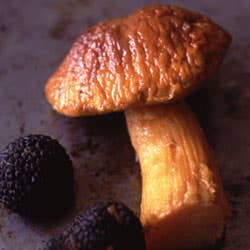
If the "black" wine of Cahors has been famous for centuries, another black treasure drawn from local earth has earned the Quercy region a certain notoriety in the past 150 years or so. This of course is the black truffle, Tuber melanosporum, one of the greatest of all gastronomic delicacies. Though the truffles of the Perigord, immediately northwest of Quercy, are better known, the precious tubers have been harvested on Quercy's causses, or arid plains, since at least the late 19th century, and are an integral part of the local cuisine. Ironically, it was the destruction of the region's vineyards by phylloxera around 1880 that gave impetus to the truffle industry here: Recognizing that the thin soil and porous limestone earth of the causses offered ideal growing conditions for truffles, many local farmers replaced their ravaged vines with truffle oaks—whose root systems provide nutrients for the soil, encouraging the tubers to form (even as the truffles feed the trees). Though no one has yet cultivated truffles consistently (one of the leading experimenters in the field is Cahors-based truffle merchant Jacques Pebeyre), these farmers were largely successful in their efforts. In the winter months today, many Quercy towns have truffle markets offering the black jewels to wholesale and retail customers alike. Martel, in the northern reaches of Quercy, is the site of a particularly famous one. There is even a truffle cooperative in Sauzet, near Cahors itself.
Keep Reading
Continue to Next Story










